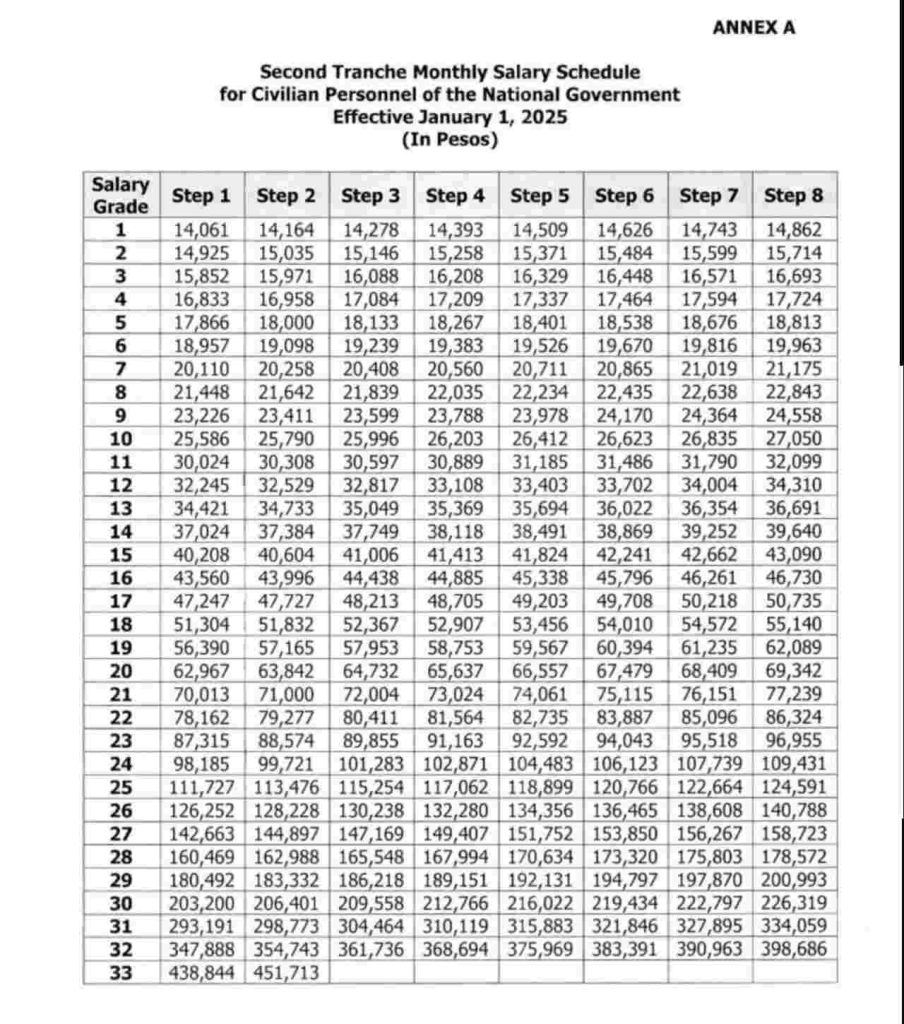Government employees in the Philippines can look forward to increased pay starting January 2025, as the second tranche of the Salary Standardization Law (SSL) takes effect. This adjustment, outlined in the National Budget Circular 597 released by the Department of Budget and Management (DBM), was part of President Ferdinand “Bongbong” Marcos Jr.’s commitment to improving public servants’ welfare, with the goal of addressing the economic challenges and improving the quality of life for government workers.
DBM Secretary Amenah Pangandaman emphasized the importance of this move, stating:
“We hope that this second tranche will help address the financial needs of our government workers, particularly given the prevailing economic challenges.”
This increase is part of a four-year salary adjustment program, with yearly increments starting in 2024 and ending in 2027.
Salary Increase Overview
Public servants can now look forward to a revised pay scale, under the updated SSL. This adjustment reflects the government’s commitment to aligning wages with inflation and rising living costs. The salary hike will be funded through the 2025 national budget’s Miscellaneous Personnel Benefits Fund. For GOCCs covered by the circular, their operating budgets will finance the adjustments.
Using the Salary Schedule Table

The salary increase follows a structured approach to ensure equitable benefits across all categories of public servants. This change is also outlined in the new salary matrix released by DBM, showing the detailed incremental adjustments based on each job salary grades and steps starting January 1, 2025.
- Salary Grade (SG)
- The “Salary Grade” column on the left shows the rank or position level of an employee.
- Government positions are classified from Salary Grade 1 (lowest rank) to Salary Grade 33 (highest rank).
- Steps
- Each Salary Grade has eight “Steps” listed in columns across the table.
- A “Step” represents the progression or length of service of an employee within their Salary Grade. For example:
- Step 1: The base salary for someone newly hired at a specific Salary Grade.
- Step 8: The highest salary an employee can receive within their grade.
- Monthly Salary (in Pesos)
- The numbers in the table show the monthly salary for each Salary Grade and Step.
- For example:
- If you are at Salary Grade 10, Step 1, your monthly salary will be ₱25,586.
- If you move to Step 2 within the same grade, your salary increases to ₱25,790.
- Increases Across Grades and Steps
- As the Salary Grade increases, the salary also gets higher. For instance:
- Salary Grade 1, Step 1 earns ₱14,061, while Salary Grade 10, Step 1 earns ₱25,586.
- The higher steps within a Salary Grade also earn more. For example:
- Salary Grade 20, Step 1 earns ₱51,304, while Step 8 earns ₱55,140.
- As the Salary Grade increases, the salary also gets higher. For instance:
Practical Example
Let’s say you are a teacher classified as Salary Grade 11:
- If you are newly hired (Step 1), you will earn ₱30,024 per month.
- If you’ve been serving for a few years and reach Step 4, your salary increases to ₱30,889.
Why Steps Matter
- Employees progress through the steps based on years of service or performance.
- The salary table ensures fairness and rewards government employees for their loyalty and experience.
Why Understanding the Salary Matrix is Important
Here are some of the reasons why it’s best to understand how the salary matrix is used:
- Transparency: Knowing where your current pay falls within the SSL framework ensures clarity and helps identify potential growth opportunities.
- Budgeting: Employees can better plan their finances by understanding their current and future earning potential.
- Dispute Resolution: In case of discrepancies in salary payments, the SSL table serves as a reference point to resolve issues effectively.
- Career Planning: Public servants can make informed decisions about career progression and promotions by analyzing the salary structure.
Who Benefits from the 2025 Salary Increase?
The second tranche of the salary hike applies to civilian government personnel in various branches and offices regardless of appointment type (regular, casual, contractual, appointive, or elective) and work basis (full-time or part-time), including:
- Executive, Legislative, and Judicial Branches
- Constitutional Commissions and Offices
- State Universities and Colleges (SUCs)
- Government-Owned and Controlled Corporations (GOCCs) that are covered by the circular.
This broad coverage ensures most public servants will benefit from the salary increase, providing them with additional financial support.
Who Is Not Covered?
While many public servants will enjoy the pay hike, certain groups are exempt from this hike, including:
- Military and uniformed personnel.
- Agencies exempt from RA 6758 (Compensation and Position Classification Act of 1989) or covered by EO 150 and RA 10149 (GOCC Governance Act of 2011).
- Individuals without employer-employee relationships, such as consultants, job orders, and student workers.
Notes and Tips on the 2025 Salary Increase
For your reference, here are some important notes related to this salary hike for government employees:
- Rules for Salary Adjustment
- Salaries will be adjusted based on the Salary Grade (SG) and Step as of December 31, 2024.
- Personnel earning more than the Step 8 rate of their salary grade will not receive an increase.
- New hires start at Step 1 of their respective salary grade.
- Casual and contractual personnel’s wages will also be adjusted proportionately (daily wage = monthly rate ÷ 22).
- GOCCs must sustain salary adjustments without external funding or loans.
- Agencies must issue Notices of Salary Adjustment (NOSA) for affected employees.
- Overpayments must be refunded if errors are discovered during auditing.
Additional Guidelines
- Incumbent Employees: Salary is adjusted to the next higher step if their current salary falls between steps.
- Reassigned/Demoted Employees: Salary is adjusted based on their new position but without reducing their existing salary if it exceeds the rate for their new role.
- Non-Diminution of Pay Rule: Employees whose pay exceeds the salary grade’s maximum rate will retain their current salary but will not get additional increments.
Video: 2025 Salary Hike for Philippine Public Servants
The second tranche of the Salary Standardization Law is more than just a pay raise; it is a testament to the government’s commitment to improving the lives of its employees. By investing in public servants, the administration is paving the way for a more efficient and motivated workforce capable of meeting the nation’s needs. To learn more about the new salary increase and the salary matrix associated with this pay hike, you may check out this video from Teleradyo Serbisyo:
